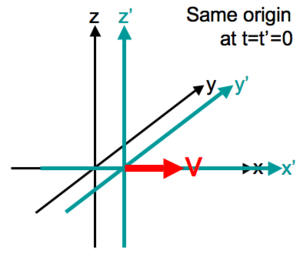I am currently studying special relativity using tensors. My lecture notes (which happen to be publicly accessible, see top of page 99) say that the standard configuration can be viewed as a rotation in the x-t plane. Can anyone explain this a bit? Is there a good way to visualize it?
The Standard configuration;

I would prefer an intuitive (not rigorous) explanation over a maths one, but if you have a maths one then for completeness it would be good to post it.
All other notes from these lectures are available here.
Answer
You probably already understand that merely rotating a coordinate system does not change the physical system you're modeling. Given one set of axes, any rotation of those axes just represents some freedom of choice to do math how you see fit.
So with that in mind, if you were pointing northeast (and chose a pair of coordinate axes to point northeast and northwest) and had a compass (pointing north), you'd have the freedom to rotate your coordinate axes to point north instead, simplifying the description of the compass direction.
Similarly, an object traveling with nonzero velocity traces out a diagonal line on the $tx$-plane, but there is a single, well-defined group of operations that could align the $t$-axis with such a diagonal line. This is analogous to a rotation.
I say analogous it's not exactly a rotation the way we typically think of it. We think of rotations as tracing out circles. That's because rotations preserve distance, and a circle is a uniform distance from its center.
But in spacetime, on the $tx$-plane, we have to think of "distance" as being the spacetime interval, and a curve of constant interval isn't a circle--it's a hyperbola. And in this case, we're talking about a hyperbola with diagonal asymptotes. Those asymptotes are the lines that light follow, unreachable by any "rotation" on the $tx$-plane.
This operation is every bit a "rotation" as our usual 3d rotations are; perpendicular vectors stay perpendicular under it, and so on. It's just the equivalent of a rotation for a different kind of underlying space(time) than regular old 3d space.
And so, it is convenient that we don't typically call this a "rotation" in so many words, but we give this operation its own name: the Lorentz transformation.
Using the Lorentz transformation to put some align a four-velocity with the $t$-direction is no different from aligning one's $xyz$-directions with east, north, and up. It's an arbitrary choice, one that you don't have to abide by if it's inconvenient, but just as there always exists a rotation to align one's $xyz$-directions that way, there always exists a Lorentz transformation to align the four-velocity of a massive object with the $t$-direction.
No comments:
Post a Comment